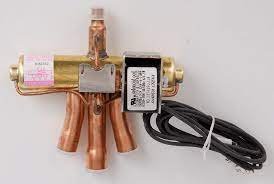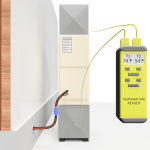Heat Pump vs Heat Strip: When it comes to heating your home, you have numerous options to choose from. However, one of the most common issues that homeowners face is deciding whether to use a heat pump or a heat strip. Both of these heating systems have their advantages and disadvantages, so the best one for you depends on various factors such as your climate, budget, energy efficiency preferences, and comfort level. In this blog post, we will compare and contrast heat pumps and heat strips to help you determine which one is suitable for your home.
What is a Heat Pump?
A heat pump efficiently transfers heat using a refrigerant. Operating in heating and cooling modes, it extracts warmth from the outside air during winter and releases it indoors. Conversely, in cooling mode, it reverses the process. The system comprises an outdoor unit housing the compressor, condenser coil, expansion valve, and an indoor unit containing the evaporator coil and fan. The refrigerant circulates between these units, changing states to absorb and release heat.
In terms of efficiency, a heat pump outperforms a heat strip, using less electricity. However, a heat pump may struggle in extremely cold temperatures (around 35°F). In such cases, a backup, such as a heat strip, might be necessary to maintain the desired indoor temperature.
What is a Heat Strip?
A heat strip is an electric heating element installed inside your heating system’s air handler. A heat strip converts electricity into heat and then blows the air through the ducts into your home. A heat strip can also be referred to as an auxiliary or emergency heat source, as it is often used to supplement a heat pump when the outside temperature is too low for the heat pump to operate efficiently.
You Can also Learn more about Delta T In HVAC System: What It Is And Why It Matters 2023
A heat strip is usually cheaper to purchase and install than a heat pump, as it has fewer parts and requires less maintenance. However, a heat strip is also less efficient than a heat pump, as it consumes more electricity to produce the same heat. A heat strip may also cause your electric bills to increase significantly, primarily if you use it frequently or for long periods.
Heat Pump vs Heat Strip: Comparison
To help you compare and contrast heat pumps and heat strips, we have summarized the Heat pump vs heat strip pros and cons in the table below.
| Heat Pump | Heat Strip |
| Can provide both heating and cooling | Can only provide heating |
| Uses refrigerant to transfer heat from one place to another | Uses electricity to generate heat from a heating element |
| More efficient and eco-friendly than a heat strip | Less efficient and eco-friendly than a heat pump |
| More expensive to purchase and install than a heat strip | Requires minimal maintenance and servicing |
| Requires a backup or supplemental heating source in very cold weather | Can be used as a backup or supplemental heating source for a heat pump |
| Needs regular maintenance and servicing to ensure optimal performance | Needs minimal maintenance and servicing |
| Has a longer lifespan than a heat strip | Has a shorter lifespan than a heat pump |
Heating and Cooling
Heat pumps offer heating and cooling, unlike heat strips that only provide heating. They operate year-round, adjusting automatically based on thermostat settings and outdoor temperature. In contrast, heat strips require manual control.
The choice between them affects comfort, energy consumption, and costs. If you experience varied weather, a heat pump suits you, maintaining comfort without a separate cooling system. A heat strip may suffice for regions with milder climates, especially if you have alternative cooling options.
Efficiency and Eco-Friendliness
Heat pumps outshine heat strips in efficiency and eco-friendliness, using less electricity and emitting fewer greenhouse gases. Heat pumps transfer heat, achieving up to four times more heat output per unit of electricity than heat strips.
This difference affects energy bills and environmental impact. Opting for a heat pump can reduce electric bills and carbon footprint, while a heat strip may be suitable for those on a budget or with access to cheap, renewable electricity.
Cost and Installation
Heat pumps are pricier to purchase and install than heat strips due to additional parts and labor. Costs range from $3,000 to $10,000 for a heat pump and $300 to $1,000 for a heat strip. Installation times vary significantly, with heat pumps taking longer.
Don’t forget to learn more about 11 Common HVAC Mistakes That Can Cost You Money And Comfort.
This distinction impacts initial investment and long-term savings. A heat pump’s efficiency may justify the higher upfront cost for larger budgets seeking a lasting solution. Conversely, a lower-cost heat strip may be a suitable short-term option if budget constraints exist.
Backup and Supplemental Heating
Heat pumps necessitate a backup heating source in freezing weather, while heat strips can serve as backup or additional heating for a heat pump. Cold climates may require a reliable heat strip to avoid malfunctions or failures in extreme temperatures, ensuring consistent heating.
This difference is crucial for those in colder climates, where a heat strip provides reliable heating. In milder climates, a heat pump can offer efficient, eco-friendly heating, utilizing only heat strips when necessary.
Maintenance and Servicing
Heat pumps demand regular maintenance for optimal performance due to their numerous components. This includes cleaning and inspection at least once a year. In contrast, heat strips require minimal maintenance, with fewer worn-out parts.
This distinction affects maintenance costs and frequency. A heat pump is suitable if you prioritize a longer system lifespan and are willing to invest time and money in maintenance. However, if cost and maintenance time are concerns, a heat strip with a shorter lifespan may be a practical choice.
Heat Pump vs. Heat Strip Lifespan Comparison
One of the factors that you may want to consider when choosing between a heat pump and a heat strip is their lifespan. How long can you expect your heating system to last before replacing it? According to HVAC experts, a heat pump can last up to 20 years with proper care and maintenance, while a heat strip can last up to 10 years with minimal care and maintenance. This means a heat pump can have a longer lifespan than a heat strip but may require more frequent servicing and repairs.
Heat Pump vs Heat Strip: Which One is Better for Your Home?
The answer to this question depends on factors such as your climate, budget, energy efficiency preferences, and comfort level. Here are some general guidelines to help you make an informed decision.
Mild or Moderate Climate
In temperate climates where freezing temperatures are rare, a heat pump offers heating and cooling, promising long-term energy and cost savings.
Cold or Extreme Climate
For colder climates with frequent freezing temperatures, a heat strip provides reliable heating, minimizing the risk of a heat pump malfunctioning in very low temperatures.
Limited Budget Consideration
With a limited budget, a heat strip is a cost-effective choice with lower upfront costs and installation fees. However, weigh a heat pump’s operating costs and long-term savings, which may pay for itself over time.
Don’t forget to learn more about HSPF5 Vs HSPF4: Heat Pump Efficiency Ratings.
Energy Efficiency and Environmental Impact:
Prioritize energy efficiency and environmental impact. A heat pump outshines a heat strip, using less electricity and emitting fewer greenhouse gases. Yet, consider electricity sources and costs, which may vary based on regional rates and renewable or non-renewable sources.
Comfort and Convenience
If comfort and convenience are paramount, a heat pump ensures even and consistent heating and cooling, adjusting automatically to outdoor conditions. However, factor in noise levels and maintenance, as a heat pump may require more frequent servicing and produce more sound than a heat strip.
Do all heat pumps have heat strips?
No, Not all heat pumps are equipped with heat strips. Heat strips are additional electrical resistance heaters that provide supplementary heat when the outdoor temperature is too low for the heat pump to operate efficiently. Although most heat pumps come with heat strips, some newer models do not require them. Modern heat pumps are more efficient and can work in colder temperatures than older models.
Here are some reasons why a heat pump may not need heat strips:
- The heat pump is installed in a location with mild winters.
- The homeowner tolerates a lower comfort level during freezing weather.
- The homeowner is concerned about the cost of operating heat strips.
If you are considering purchasing a heat pump without heat strips, it is essential to consult with your HVAC contractor to ensure that it is a good option for your home. They can help you evaluate your climate and heating requirements.
Conclusion
Heat pumps and heat strips are two standard heating options for your house, each with pros and cons. The best one depends on your preferences and circumstances; no one-size-fits-all solution exists. We hope this blog post has helped you understand the differences and similarities between heat pumps and heat strips and given you some valuable tips to help you choose the right one for your home. If you have any questions or comments, please leave them below. Thank you for reading!





